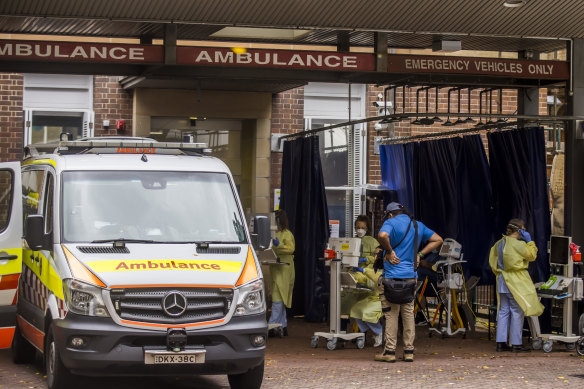- Exclusive
- National
- NSW
- Coronavirus pandemic
This was published 3 years ago
RPA department head lashes ‘politically-driven’ management of crisis
By Lucy Carroll and Mary Ward
A high-ranking doctor from one of Sydney’s biggest hospitals has lashed the “politically driven” management of the pandemic, as thousands of health staff remain on COVID-19 leave and the number of hospitals treating coronavirus patients has grown to nearly 100.
In a video briefing to junior staff, Royal Prince Alfred Hospital executive clinical director Professor Paul Torzillo told doctors that directives from state and federal health departments were being filtered by the hospital to determine what was appropriate for staff and patients.

The emergency department at Royal Prince Alfred Hospital in Camperdown. Credit: Anna Kucera
“Increasingly, the pronouncements coming from government are completely politically driven and ... not health-based,” he said in a recording viewed by the Herald.
There are now 95 hospitals managing coronavirus patients across NSW – up from 73 last week. About 5300 staff are on leave due to COVID-19 exposure, placing huge strain on the system.
The video from last week featuring Professor Torzillo is a rare insight into the unvarnished views of senior health staff and how the health system is caught between the pressures of shortening isolation for health workers and the need to keep the infection out of hospitals.
Professor Torzillo’s declined to comment on the clip, but told the Herald that “opening up in the weeks before Christmas was inappropriate”.
“It will take a long time for the state’s health system to recover, with many patients not seen in a timely way and a huge burden of work to catch up on,” he said.
“Some of the guidelines around de-isolation for health staff and use of rapid tests which apply in community are not appropriate in hospitals where we need to be more cautious,” he added, noting more conservative decisions should be taken in hospitals, especially on the time patients and staff spend in isolation.
NSW Health Minister Brad Hazzard declined to comment but the NSW government has previously stressed the system can cope with the Omicron wave.
The record number of COVID-positive hospital patients – there were 2863 on Wednesday – has triggered the activation of additional surge staff plans. There were 217 people in intensive care, below the peak of 244 in September during the Delta outbreak.
Staff at Westmead Hospital’s intensive care unit who were not authorised to speak publicly confirmed on Wednesday that their unit had moved to a “level one” escalation of its surge plan, used during a depletion of skilled core staff.
Federal Health Minister Greg Hunt on Tuesday announced plans to deploy private hospital resources to state systems to manage the case surge, but his NSW counterpart Brad Hazzard told the Herald the preferred model in NSW “is to transfer patients to private hospitals, respecting that staff are in teams in known environments which, in our view, works best for staff and patients”.
Under the level one measures deployed at Westmead, intensive care doctors can be supplemented with non-ICU critical care medical officers such as anaesthetists, and other staff such as physiotherapists, speech pathologists and dietitians. Non-ICU support staff, including administrative staff, can also be called to work in the unit.
“A hospital system that’s coping does not require hospital executives to provide clinical care, it does not require allied health admin staff to provide clinical care and those are definitely themes that we’re seeing across the surge plans,” said the acting general secretary of the NSW Nurses and Midwives Association Shaye Candish.
About 50 intensive care nurses held a protest at the hospital earlier in the day in what they described as a desperate bid to increase staffing levels.
Holding a sign which read “stop playing with people’s lives”, nurse Amy Halvorsen told reporters she had quit her job in December due to her frustration and exhaustion.
“We don’t want ‘thank you’, we want safe staffing,” she said in a plea to the state government.
Timothy Blofield, secretary of the hospital’s union branch, said there was “massive amounts” of overtime occurring at the hospital, with some nurses required to work up to 20 hours straight.
Nurses said there had been talks of possible strike action if no change occurred.
Ms Candish said there was “broad discussion” of strike action among members at some hospitals.
“If and when our members make that decision then, yes, they would be supported by the union. But right now our members are mostly concerned about getting through this pandemic,” she said.
With the number of active cases in aged care staff across Australia members approaching 4000, unions and operators on Wednesday called for an urgent response from the federal government.
The Aged Care Collaboration, which represents major providers and unions, said they would support a military response to aged care’s staffing crisis, noting providers needed immediate access to a dedicated rapid antigen test supply.
The Health Services Union said it also wanted the federal government to consider paying “everyday Australians” to work in aged care, performing roles that required minimal training such as food delivery.
But after it was announced the military would be deployed to drive ambulances in Victoria, Prime Minister Scott Morrison said there was a limit to how much support the Australian Defence Force could provide.
“There is not some shadow workforce that sits in the defence forces or somewhere else that can automatically just replace furloughed [hospital] staff because they have COVID,” Mr Morrison said.
Stay across the most crucial developments related to the pandemic with the Coronavirus Update. Sign up for the weekly newsletter.